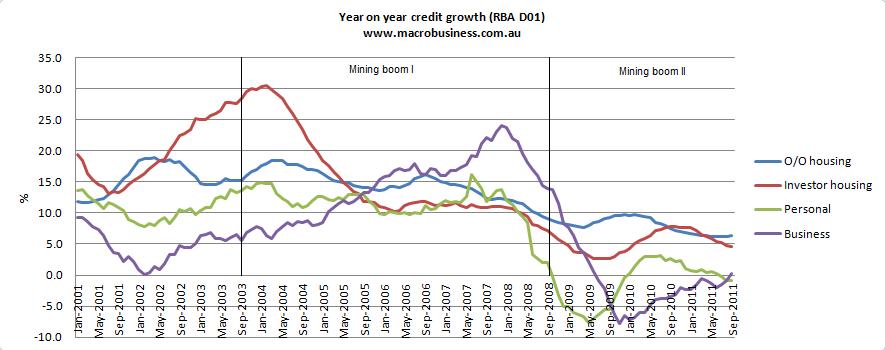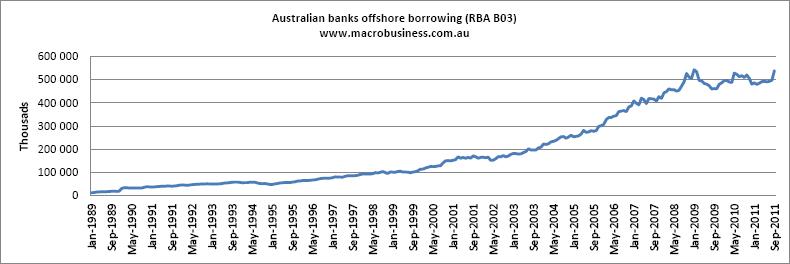Throughout this year, I have posited that Australia is now a one speed economy – slow. That this has transpired amidst a mining boom has amazed and befuddled economists and media alike. But it’a really not all that hard to understand. Offsetting the mining boom is a huge and unprecedented slowdown in the issuance of credit. Check out the following chart, which is the history of the growth rates of total credit in Australia:

I’ve marked the beginning and end of the two mining booms to show the clear difference between the two. All dimensions of private credit expanded powerfully through much of Mining boom I. Conversely, all dimensions of private credit have fallen to historically very low levels in Mining boom II.
This is well known these days. But it is very important to understand why this has transpired. The RBA, government and media are fond of repeating the line that this is the result of “consumer caution”. By couching disleveraging in these terms, all three institutions are characterising the outcome as a choice.
But it isn’t a choice at all and the RBA’s own jawboning and rate rises throughout 2010/11 has hinted at this truth. Australian households can no longer expand their debts without also gathering to themselves imprudent levels of risk. The reason for this is that much of the credit boom of the past decade was fueled by our major banks borrowing offshore:

Notice the distinct upward shift in the trend from the turn of the millennium when banks mastered the interest rate and currency swaps that enabled them to borrow huge sums from foreign investors.
But all of this growth came with a secret risk. The foreign borrowing was never planned to be paid back. When the short and long term bonds that underpin the borrowing come to maturity, they are either rolled over or new bonds are issued to new investors. The risk, then, is that when the investors that participate in global funding markets get nervous, they start to raise the yield that they demand to renew these bonds and Australian banks suddenly find themselves facing much more expensive funding. That is what happened during the GFC and the same thing is happening now with the European crisis.
This ongoing liability risk is why the credit rating agency, Standard & Poors, last week downgraded Australia’s Banking Industry Country Risk (BICRA) score:
In our view, weaknesses for the Australian banking sector are its material dependence on net external borrowings, which fund about 24% of domestic customer loans; and limited support from core customer deposits, which fund only about 38% of domestic customer loans. We consider that these weaknesses are partly offset by a domestic debt capital market that can support the banking sector and the government and central bank, whom we view as responsive and flexible to banks’ funding needs.
We classify the Australian government as being “highly supportive” of the banking system, reflecting our expectation of timely financial support to ensure the stability of the financial system, if needed. This assessment factors in a well-developed administrative and institutional framework that should facilitate a timely and coordinated response, and a track record of proactive and prompt support for the banking system through measures such as guarantees for retail and wholesale funding during the global financial crisis. We believe that the existing legislation, policy, and relationships with supranational agencies do not hinder the Australian government from assisting the banking system.
S&P is saying that the promise of Federal government guarantees in times of stress prevents further downgrades to the banks credit ratings now. In a similar review six months ago, Moody’s rated this support as worth two notches, which is material.
There are two implications that flow from this. The first goes back to my earlier point about Australians being unable to accumulate more debt because the banks cannot expand their offshore borrowing further without risking downgrades from Moody’s and S&P. The second point is that the state of the Federal budget is now inseparable from the credit ratings of the banks. This means that the Budget must always be straining for surplus, limiting its pro and counter cyclical efficacy. That is, you can forget tax cuts for as far as the eye can see, and any further stimulus packages in times of weakness aren’t going be anywhere near as spectacular as that deployed in 2008, another reason why we are condemned to slow growth.
In effect, what has happened since 2008, is that the various rules of Australia’s previous political economy – the divisions between public and private interests and budgets – have been bashed, bent and broken into a scaffold to support the banks, their inflated assets (our houses) and their offshore borrowing.
Of course, I have said all of this before. But I want to add one very important new insight. On Friday, MB published a new note from the excellent Russell Jones, strategic analyst at Westpac, on the fallout from the European crisis. He described four dimensions of a new era:
Competitive Devaluation.
As the Gold Standard system of fixed exchange rates progressively collapsed after Britain’s forced exit in September 1931, governments sought to maintain industrial competitiveness through the deliberate manipulation of their nominal exchange rates relative to those of their major trading partners. Such approaches are already making a comeback. Both the Swiss and the Japanese authorities have acted to cap their exchange rates via of official intervention in the fx market in an effort to offset safe haven flows into their respective currencies, minimise the damage being done to their tradable goods sectors, and reduce deflationary pressures. At the same time, since 1997 manydeveloping economies, not least China and much of the rest of Asia, have actively managed their exchange rates to a greater or a lesser degree via the accumulation of huge stockpiles of foreignexchange reserves in order to encourage export-led growth. Such policies are only likely to become more popular as global demand growth softens.Protection.
Protection is a very seductive policy in that it offers immediate political gains in tough economic times by safe-guarding jobs in those industries threatened by international competition, and where more often than not vested interests are most vocal, while any costs in terms of higher prices or compromised productivity growth are typically delayed and more thinly spread across the population.Resort to import tariffs and quotas and export subsidies proliferated in tit for tat fashion in the 1930s,especially once the US and UK, the two dominant economies of that era, had adopted such policies Today, both President Obama and a number of the Republican candidates for the White House havealready adopted some alarmingly protectionist rhetoric (not least towards China) as the 2012 White House election campaign gets under way. There is a risk that should the domestic US economic environment deteriorate dramatically, and fiscal policy remain compromised because of the polarisation of Congress, the President runs on an explicitly protectionist ticket. This can only be a red rag to a bull for the US’s trade competitors, especially those in the developing world.Default.
History suggests that sovereign defaults are rarely isolated events. Rather they occur intemporal and geographical clusters. The 1930s saw a catalogue of debt repudiations and restructurings -most compulsory, some voluntary – as the Gold Standard collapsed and fiscal deflation proved self defeating in an aggressively deflationary environment, with Europe and Latin America particularly proneto default. In the current environment, Greece has already restructured its debts and the likelihood is thatother economies in the Eurozone periphery, if not the outer core, will have to follow suit before too long,especially if the developing downturn proves serious.Financial Repression.
Ever tighter capital account restrictions, exchange controls and increaseddomestic regulation of financial sectors proved to be consistent features of the 1930s. These traitscontinued during the Second World War and its aftermath as governments grappled with hugely expanded levels of debt, often combining policies of regulatory coercion with a dose of inflation to easethe real burden of those liabilities. The OECD economies are now facing similarly rapidly escalating levels of public sector debt to those which emerged 60 or 70 year ago. Hence, there is good reason to believe that the policy response will be comparable. Governments are likely to encourage home bias or endeavour to create captive audiences for their debt via supposedly prudential regulatory changes applied to banks and pension funds, transactions taxes, or the outright public ownership or control of financial institutions.
I take three points from Jones’s exceptional note. The first is that the world is confronting a huge and enduring paradigm shift. The changes Jones’ describes are enduring, a break from yesterday’s progressing globalisation and expanding capital markets towards a much more managed brand of capitalism.
Second, this new paradigm will be hostile to debt and will value countries, currencies and economic models that are powered by trading success and strong current accounts. Real economies, not financially engineered ones.
Third, we can expect ongoing freezes in global funding and more expensive capital over time.
So, if this is the new normal, how do we make sense of Australia’s current economic model? The rise of banks, known elsewhere as financialisation, evolved in a global circumstance of similar credit-dependent economic models, especially in the Anglosphere. In Australia it was accepted under a new doctrine called the Pitchford Thesis that said that such borrowing and the current account deficits that it created was no risk so long as it was in the private sector.
Whatever the causes, the effects were dramatic. Financialisation enabled the banks to dramatically grow their share of GDP. Note, again, the increasing ramp after the millennium. Note, too, the concurrent rise of wholesale and retail trade, which is now rolling over:

In the new environment described by Jones, the mining boom has so far enabled the our old model to hold together because of high income growth and savings accelerating the rebalancing of the banks funding profiles towards domestic deposits, as well as boosting government tax receipts. But what happens now that the terms of trade and the investment benefits of the boom have peaked? We are already cutting interest rates in response to this and in the old economic model this would have boosted borrowing, as well as consumption to fill the gap.
If this last’s any period of time, the likely outcome is continued pressure on the banks to borrow more money offshore and a widening current account deficit. But in Jones’s new normal, is that remotely sensible?
To my mind, the key to a solution for this dilemma is still rate cuts. Cuts will also cause our dollar to fall and make all of our exports more competitive again. This will boost capital formation and incomes in our external sector, growing its influence over GDP growth.
But the rebalancing will only happen if the banks (and the people) are prevented from blowing it all on another mad round of housing speculation. The answer might be macro-prudential rules for the banks.
We need an entirely new economic narrative in this country based around the preeminence of exports, as well as the tools to make it happen and the fortitude to use them.

